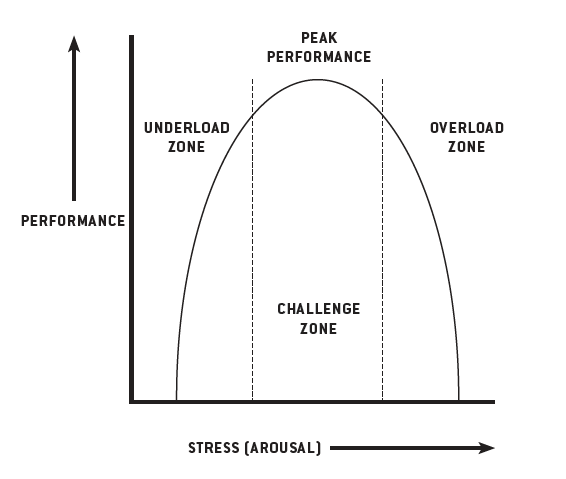

Ben Ramalingam introduces his new book
In Upshift: Turning Pressure into Performance and Crisis into Creativity, I set out to explore how stress, pressure and crisis can be transformed into performance and creativity through a process that I call ‘Upshifting’.
This book was originally inspired by my work on humanitarian innovation. But as I researched and learned, the scope expanded to explore how people have transcended pressure and crises in all realms of human experience. The book covers examples from the everyday, like the daily commute, to the epic, like space travel.
In this blog, I’d like to share three key messages from the book with you.
Message 1: The inverted U-curve that links pressure and performance.
A series of famous experiments from the early 20th century first identified an inverted U-curve that links pressure and performance.

In a wide variety of settings, our performance in creative and problem-solving tasks actually increases with stress, up to a threshold point. When we experience too much stress beyond this point, we get overloaded. It’s hard to organize our thoughts and gain control of the situation. But too little stress is no good either— below the threshold, we quickly become disengaged, demotivated, and unfulfilled.
In this Goldilocks zone, between cognitive overload and underload, where stress is neither too little nor too much, but just right, lies the zone of optimal performance – the zone of Upshifting. Here we have enough pressure and stress to keep us on our toes, but not so much that it becomes overwhelming.
This zone varies for different people facing different problems in different situations – your optimal point of stress versus performance will be different to mine. But we can all learn to better reach and maintain optimal performance under pressure.
Message 2 The three ingredients of Upshifting are Mentality, Originality and Purpose.
Mentality is our ability to reframe the situations we face so that we feel we’re taking on challenges rather than facing threats. Such reframing sets up a series of changes to the chemistry of the brain that focuses our attention and sharpens our performance. Extensive studies show that pressure can become a source of positive energy that aids performance in a whole range of settings. It enables students to better manage stress, free divers reach new records, pilots to land malfunctioning planes, and even separates Olympic champions from other elite athletes.
Mentality opens the door to Upshifting, but to walk through the door we need to harness originality.
Among people working in the peak performance zone – including fighter pilots, medical responders, firefighters and surgeons – there is a clear pattern of being able to use divergent thinking under pressure, generating creative ideas by exploring many possible solutions.
Our ability to do this hinges on psychological and cognitive factors. But this is not a fixed capability – as with our ways of managing stress, we all have different starting points but we can all also learn to be more original.
Research shows that by using simple divergent thinking tools regularly, we can enhance our creative thinking, and it can even lead to long-term improvements in our cognitive capabilities and psychological resilience.
Finally, attaining and sustaining Upshifts comes down to our sense of meaning and purpose. This has a profound impact on whether and how we reach and maintain our optimal performance. Medical research has proven that a greater sense of purpose can help us live longer, happier, healthier lives. Life purpose is linked to lower incidence of acute and chronic diseases.
And in situations where pressure can’t be avoided, you can get people to be creative by instilling a meaningful purpose, where we have a sense that there is an important, urgent need for the work we do.

Figure 2: How creativity emerges from pressure and purpose
Message 3 The six kinds of Upshifters
The third message is gleaned from people working in many different high-pressure contexts – from humanitarian responses, to emergency services and pandemic response, to the military, space exploration, surgery, even the performing arts.
There is no single best way of performing under pressure. Rather there are six different Upshifter archetypes, each of which harnesses our distinctive problem-solving skills, creativity and imagination in different ways:
- Constructively challenging the status quo of how things are done
- Crafting solutions based on a deep understanding of how technical and social aspects fuse together.
- Combining ideas across diverse fields.
- Connecting with the right people at the right time.
- Corroborating approaches, judging what’s good or bad on the basis of whether it works or not.
- Conducting collective efforts into shared and sustained missions.
I believe we can use these archetypes to democratise the very ideas of creativity and innovation – to embrace the diversity and plurality of our cognitive capabilities.
Overall, in Upshift I try to challenge the assumption that crises kill creativity. For a whole range of problems, in many different settings, people are finding, managing and dealing with pressure and stress in ways that don’t lower their creative abilities – they enhance them. In fact, successful innovators around the world have tapped into this to attain new levels of human and professional excellence.
We now live in a world of perpetual simultaneous crises – what has been termed the polycrisis. To better manage and cope, we need to see constraints and limitations not as restrictions but as a source of freedom. As Nobel Laureate Ilya Prirogine eloquently put it, our world may be uncertain, but that uncertainty is at the very heart of human creativity.
PS The brilliant folk at We Are Cognitive have made a short animated film about Upshift – take a look below.